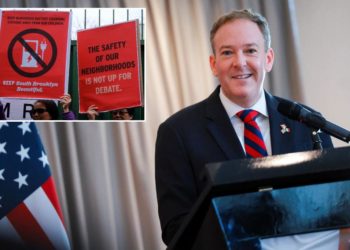Satisfaction and frustration most accurately capture what should be America’s reaction to last month’s Israeli-U.S. military strikes on Iran.
Satisfaction because the raids, particularly against the nuclear-weapons program, may have achieved what decades of illusion, naïveté, misguided diplomacy and inadequate economic sanctions failed to achieve, and frustration because the strikes were terminated early and unnecessarily.
It remains to be seen if Washington has learned enough of a lesson to complete the destruction of Iran’s nuclear infrastructure, by military means if necessary. As on many previous occasions, Iran has announced that it will cease cooperation with the International Atomic Energy Agency, demonstrating that there is currently no serious chance of a satisfactory diplomatic solution.
The early signs are mixed and opaque. Much depends on the stability of the ayatollahs’ regime and its internal divisions, and whether Iran’s population will publicly express its discontent.
Unfortunately, the opposition in Iran, while national in scope, is not well organized, and the regime’s potential for brutal repression has been repeatedly demonstrated. Much also depends on whether America’s leaders have the necessary resolve, focus and persistence — a matter in considerable doubt.
The Middle East has changed significantly since Iranian proxies enacted on Oct. 7, 2023, the culmination of the Islamic republic’s “Ring of Fire” strategy — surrounding Israel with enemies, including Hezbollah in Lebanon, Hamas and Islamic Jihad in Gaza and foreign militias in Syria. Along almost every important strategic dimension, Iran is today far weaker, and Israel (and the United States) far stronger.
Nuclear-weapons factors of production delayed are nuclear weapons denied, albeit temporarily. There is zero evidence the ayatollahs are prepared to abandon their nuclear dreams, and this is certainly not the moment for Washington to throw Tehran political or economic lifelines, particularly not a “new” nuclear deal with the United States.
Immediately after President Trump prematurely declared victory, ended U.S. strikes and forced Israel and Iran into a cease-fire, fierce debate erupted over initial estimates of the damage inflicted on Tehran’s nuclear project. With precious little evidence, Mr. Trump immediately proclaimed the “complete and total obliteration” of Iran’s efforts, while anonymous sources breathlessly maintained that a hot-off-the-presses preliminary Defense Intelligence Agency analysis concluded America had set Iran’s nuclear program back only a few months. The day after the attack, the chairman of the Joint Chiefs, Dan Caine, said accurately that it was “way too early” to make a viable assessment.
To borrow from Matthew Arnold, ignorant armies clashed by night in this battle for control of the political narrative. Only further data can clarify or perhaps resolve where the truth lies. I am satisfied for now with the subsequent conclusion of Rafael Grossi, director general of the International Atomic Energy Agency, that the Israeli-U.S. attacks caused “enormous damage” to Iran’s nuclear efforts. Enormous yes, but still not enough.
The inevitable continuing debate over whether further military force will be necessary will color both Washington’s view on Tehran’s remaining nuclear threat and how to deal with its badly weakened regime. Those who opposed using military force, including several Democratic senators who now criticize Israel and the United States for failing to destroy every aspect of Iran’s nuclear infrastructure, implicitly argue that we shouldn’t have destroyed any of it. Where is the enriched uranium, they ask? What about newer or more obscure sites of nuclear activity, like Pickaxe Mountain near Natanz? What about the reality that pummeling the physical program does not eliminate the knowledge Iran retains to rebuild it?
In a perfect world, all of Iran’s uranium, at whatever enrichment level, would be removed and stored at a safe place, like Oak Ridge, Tenn., where what was once Libya’s nuclear-weapons program was shipped. Any uranium in the hands of a proliferator is potentially dangerous.
Whatever stockpile the ayatollahs may have previously hidden or recently spirited away from known nuclear facilities is truly dangerous only when weaponized. It must be converted into uranium metal to fashion nuclear weapons. As best we know, Tehran’s conversion capabilities, both from yellowcake to UF6 and from UF6 to metal, are most likely now inoperable.
Moreover, Iran’s weapons-fabrication facilities are either known and destroyed; underground and possibly irradiated; or at least capable of being observed and therefore destroyed later. Critical here is continuous American and Israeli surveillance, and the resolve to strike again if necessary.
The existence of unknown locations cannot be discounted. But the possibility that everything was not destroyed in the first attacks is not a legitimate reason to have forsworn those attacks.
Some people are never satisfied. If the United States had instead bombed uranium-storage facilities, those opposed to the strikes would complain about releasing radioactive materials into the atmosphere. Patience and persistence are required to stifle such a dogged proliferator like Iran.
Ironically, the continued existence of the scientific and technological know-how for Iran to rebuild its nuclear capacity was precisely what concerned George W. Bush’s administration as it faced Saddam Hussein. After the Persian Gulf war of 1991, Mr. Hussein kept on his payroll some 3,000 “nuclear mujahedeen,” as he called them, to recreate Iraq’s nuclear-weapons program. They were well known to U.N. weapons inspectors after the 1991 war. After the second war in the gulf, the United States and other coalition nations had programs to keep them gainfully employed so that they could not be hired by other rogue states.
That intellectual firepower alone was a compelling argument for regime change in Iraq. Iran now has the same asset, although degraded by Israel’s most recent attacks.
Nonetheless, many are still reflexively pursuing the Holy Grail of an Iran nuclear deal, perhaps including, according to news reports, the Trump administration. Whatever efforts are made, however, will simply be a waste of oxygen.
Satisfying America’s legitimate demands requires Iran to do a full Libya, meaning real performance in denuclearizing, not just acquiescing to treaty verbiage. It requires that Iran surrender all of its weapons-related assets, meaning any enriched uranium and all remaining physical assets, including dual-use capabilities.
However, absent a change of government in Tehran, which Washington should support, a full Libya is impossible. Unlike Muammar el-Qaddafi, the mullahs, already badly humiliated, realize that further humiliation would fatally weaken their rule. They will never voluntarily accept that fate. Instead, they will resume their earlier tactic of using negotiations to string the West along until memories dim and, as the old saying goes, “zeal for a deal” takes over, as it did for Barack Obama, producing the fatally flawed 2015 Iran agreement.
Closely related to the suggestion of more diplomacy is the assumption that the International Atomic Energy Agency is the solution. Realistically, the ayatollahs are no more likely to acquiesce to the agency’s prerequisites for a proper inventory and cleanup job than they would to American or Israeli prerequisites.
The atomic energy agency does important work, but it is neither an espionage agency nor an occupying force. Much of the most important and sensitive information it has acquired over the years came from the United States, Britain and Israel. Tehran has long treated the agency with disdain, following what James Baker once called the “cheat and then retreat” strategy to defy effective international inspection. Most important, the issues Iran poses are political, not technical. The atomic agency can be useful in a future solution, but not as the centerpiece.
The all-purpose answer from those who prefer wringing their hands to accomplishing anything: Remember Iraq. The critics of the U.S. strike on Iran are fighting the last war. The worldwide terrorist proxies Iran deployed and its advanced nuclear programs are orders of magnitude more threatening than Mr. Hussein’s Iraq. Moreover, “no boots on the ground” need be involved. The short answer is that Iran is not Iraq, which Jerusalem and Washington have already partly demonstrated.
Israel most likely has the resolve to do what is necessary to ensure its survival. The real question for America’s survival is whether the same can be said for the current U.S. administration.
John R. Bolton was the U.S. ambassador to the United Nations and President Trump’s longest-serving national security adviser.
Source photograph by Yevgen Romanenko/Getty Images.
The Times is committed to publishing a diversity of letters to the editor. We’d like to hear what you think about this or any of our articles. Here are some tips. And here’s our email: [email protected].
Follow the New York Times Opinion section on Facebook, Instagram, TikTok, Bluesky, WhatsApp and Threads.
The post We Need to Finish the Job in Iran appeared first on New York Times.




